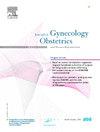Contribution of the CAESARE tool in the management of non-reassuring fetal status at risk of acidosis
IF 1.6
4区 医学
Q3 OBSTETRICS & GYNECOLOGY
Journal of gynecology obstetrics and human reproduction
Pub Date : 2025-09-16
DOI:10.1016/j.jogoh.2025.103037
引用次数: 0
Abstract
Introduction
Developed in 2020, the CAESARE tool is a decision-support tool for interpreting fetal heart rate (FHR). In a preliminary study, the use of CAESARE led to a significant reduction in caesarean section rates.
Methods
We assessed the ability of the CAESARE tool to predict acidosis earlier by reducing the time-to-intervention in cases of non-reassuring fetal status (NRFS). We performed a retrospective, single-center case-control analysis evaluating associations between CAESARE scoring and the onset of neonatal acidosis. The primary outcome was presence or absence of fetal acidosis at birth based on CAESARE score. The case population was patients whose fetuses had fetal heart rate abnormalities and an arterial pH < 7.00 at birth. The control population was patients who had fetal heart rate abnormalities without the fetuses having acidosis at birth.
Results
CAESARE influenced decisions regarding the continuation of labor. It was associated with increased end of labor in the case group (p < 0.01) and greater expectant management in the control group (p < 0.01). CAESARE sensitivity and specificity were 0.97 and 0.88, respectively.
Conclusion
In our study, 32.1% of neonatal acidosis cases could have potentially been avoided if CAESARE had been used. The tool enabled extended expectant management in 42% of cases where end of labor was recommended. These findings support the implementation of a procedure for improved FHR analysis practices.
剖宫产工具在处理不稳定胎儿状态的酸中毒风险中的作用。
CAESARE工具于2020年开发,是一种决策支持工具,用于解释胎儿心率(FHR)。在初步研究中,使用CAESARE可显著降低剖宫产率。方法:我们评估了CAESARE工具通过减少非安心胎儿状态(NRFS)病例的干预时间来早期预测酸中毒的能力。我们进行了一项回顾性、单中心病例对照分析,评估CAESARE评分与新生儿酸中毒发病之间的关系。主要结局是基于CAESARE评分的出生时是否存在胎儿酸中毒。病例人群为出生时胎儿心率异常且动脉pH < 7.00的患者。对照组为没有出生时发生酸中毒的胎儿心率异常的患者。结果:剖腹产影响了是否继续分娩的决定。结论:在我们的研究中,32.1%的新生儿酸中毒病例如果使用剖腹产是可以避免的。该工具在42%建议结束分娩的病例中延长了预期管理。这些发现支持了FHR分析实践改进程序的实施。
本文章由计算机程序翻译,如有差异,请以英文原文为准。
求助全文
约1分钟内获得全文
求助全文
来源期刊

Journal of gynecology obstetrics and human reproduction
Medicine-Obstetrics and Gynecology
CiteScore
3.70
自引率
5.30%
发文量
210
审稿时长
31 days
期刊介绍:
Formerly known as Journal de Gynécologie Obstétrique et Biologie de la Reproduction, Journal of Gynecology Obstetrics and Human Reproduction is the official Academic publication of the French College of Obstetricians and Gynecologists (Collège National des Gynécologues et Obstétriciens Français / CNGOF).
J Gynecol Obstet Hum Reprod publishes monthly, in English, research papers and techniques in the fields of Gynecology, Obstetrics, Neonatology and Human Reproduction: (guest) editorials, original articles, reviews, updates, technical notes, case reports, letters to the editor and guidelines.
Original works include clinical or laboratory investigations and clinical or equipment reports. Reviews include narrative reviews, systematic reviews and meta-analyses.
 求助内容:
求助内容: 应助结果提醒方式:
应助结果提醒方式:


